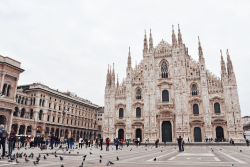Milan is the second-largest city in Italy and the capital of Lombardy. The city proper has a population of about 1.4 million, while its urban area is the 4th largest in the EU and the largest in Italy with an estimated population of about 5.27 million. The massive suburban sprawl that followed the post-war boom of the 1950s–60s and the growth of a vast commuter belt, suggest that socioeconomic linkages have expanded well beyond the boundaries of its administrative limits and its agglomeration, creating a metropolitan area of 8-12 million people.
Milan was founded by the Insubres, a Celtic people. The city was later conquered by the Romans, becoming the capital of the Western Roman Empire. During the Middle Ages, Milan flourished as a commercial and banking center. In the course of centuries, it has been alternatively dominated by the Spanish, the Austrians and the French, until when in 1859 the city was eventually annexed by the new Kingdom of Italy.
During the early 1900s, Milan led the industrialization process of the young nation, being at the very center of the economic, social and political debate. Badly affected by the World War II devastations, and after a harsh Nazi occupation, the city became the main centre of the Italian Resistance. In post-war years, the city enjoyed a prolonged economic boom, attracting large flows of immigrants from rural Southern Italy.
During the last decades, Milan has seen a dramatic rise in the number of international migrants, and today more than 1/6 of its population is foreign born. Milan is the main industrial, commercial and financial centre of Italy and a leading global city. Its business district hosts the Italian Stock Exchange (Borsa Italiana) and the headquarters of the largest national banks and companies. In terms of GDP, Milan is the wealthiest city in Italy, has the third-largest economy among EU cities after Paris and Madrid, and is the wealthiest among EU non-capital cities. It has been suggested that the Milan metropolitan area is part of the so-called Blue Banana, the area of Europe with the highest population and industrial density.
The city is a major world fashion and design capital. Thanks to its important museums, theatres and landmarks (including the Milan Cathedral, the 4th largest cathedral in the world, and Santa Maria delle Grazie, decorated with Leonardo da Vinci paintings, a UNESCO World Heritage Site) Milan attracts more than 8 million annual visitors. It hosts numerous cultural institutions and universities, with 11% of the national total of enrolled students. The city is also well known for several international events and fairs, including Milan Fashion Week, EICMA and the Milan Furniture Fair, the largest of its kind in the world. It also hosted large international events such as 2015 EXPO and will host the 2026 Winter Olympics and Paralympic games together with Cortina d'Ampezzo.
Milan is home to two of the world's major football teams, A.C. Milan and F.C. Internazionale (Inter), and one of Europe's main basketball teams, Olimpia Milano.
For more information about public transport visit: public transport
For the useful numbers visit: emergency numbers
For more information, contact us to get the guide we prepared for you with all the useful information for living in Milan!


Follow us